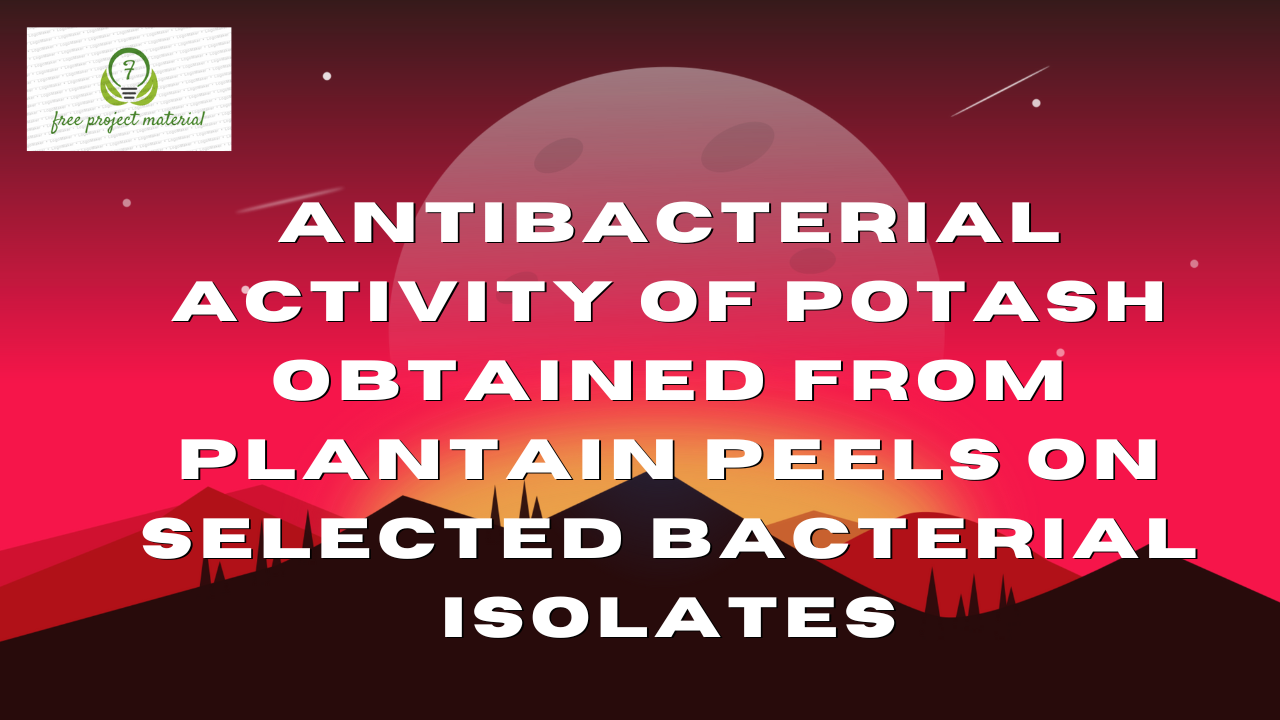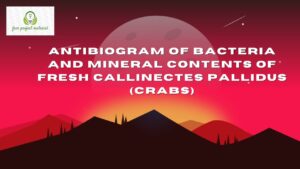ABSTRACT
The extraction of potash from plantain peels and antibacterial activity of potash obtained from plantain peels on selected bacterial isolates such as Staphylococcus sp. Escherichia sp. and Pseudomonas sp. was studied using standard analytical and microbiological method. Pseudomonas sp. was isolated from wound samples, Escherichia sp. was isolated from urine samples while Staphylococcus was isolated from nasal cavity. The samples were collected from microbiology laboratory of science technology department in Akwa Ibom State Polytechnic Ikot Osurua. The morphological and biochemical characterization of the isolates was performed to confirm the isolates. Aqueous and ethanolic extract of the plantain peels were obtained in different concentrations and disc diffusion method were used for the purpose of this study. Phytochemical screening of aqueous and ethanolic extracts reveals the presence of the following components, saponins, tannins, flavonoids, alkaloids, cardiac glycosides. The outcome of the antibacterial activity shows that in ethanol extract Staphylococcus sp. was sensitive to the extract in 100% concentration (20mm), 70% concentration (18mm) while Escherichia sp and Pseudomonas sp. were highly resistance both in aqueous and ethnaolc extracts. This study recommends that ethanolic extracts of plantain peels should be used as substitute for the treatment of infection caused by Staphylococcus sp.
TABLE OF CONTENTS
Title Page – – – – – – – – – i
Certification – – – – – – – – ii
Dedication – – – – – – – – – iii
Acknowledgments – – – – – – – iv
Abstract – – – – – – – – – v
Table of Contents – – – – – – – – v-viii
CHAPTER ONE
INTRODUCTION
1.1 Background of the Study – – – – – 1-2
1.2 Aim and objective of the Study – – – – – 3
1.3 Significance of the Study – – – – – 3
1.4 Scope and Limitation of the Study – – – – 4
CHAPTER TWO
2.1 LITERATURE REVIEW- – – – – – 5-7
2.2 Description of Plantain – – – – – – 7-9
2.3 Taxonomy of Plantain – – – – – – 9
2.3.1 Classification of Phytochemicals
and their Roles in Disease Prevention – – – – 10
2.3.2 Phenolic Compounds – – – – – – 10-13
2.3.3 Tannins – – – – – – – – 13-15
2.3.4 Alkaloids – – – – – – – – 16-18
2.3.5 Terpenoids – – – – – – – – 18-21
2.3.6 Saponin – – – – – – – – 21-22
2.4 Overview of Potash and its Extraction from Plantain Peels – 23-27
2.5 Nutritional Value of Plantain – – – – – 28-27
2.6 Uses of Plantain Peels – – – – – – 29-31
2.7 Health Benefits of Plantain Peels – – – – 31
CHAPTER THREE
MATERIALS AND METHOD
3.1 Sample collection – – – – – – – 35
3.2 Preparation of Unripe plantain peels – – – – 35
3.3 Extraction of Potash from plantain peels – – – 35-36
3.4 Subculture preparation – – – – – – 36
3.5 Preparation of stock culture – – – – – 37
3.6 Antibiotic Sensitivity pattern using disc Diffusion Method – 37-38
CHAPTR FOUR
RESULT AND DISCUSSION
4.1 Result – – – – – – – – 38-42
4.2 Discussion – – – – – – – – 42-47
CHAPTER FIVE
CONCLUSION AND RECOMMENDATION
5.1 Conclusion – – – – – – – – 48-49
5.2 Recommendation – – – – – – – 49
References
CHAPTER ONE
INTRODUCTION
1.1 Background of the Study
Plantain are considered to be amongst the most abundant fruits crops in the world. The world production is estimated to be 28 million tons of plantains and banana annually (Morton et al., 2011). This huge production figures give one an indication of the large kitchen wastes that would be generated to world over in plantain and banana peels. Potassium is the most abundant mineral in plantain peels with an estimated value of 37gkg-1 in the green peels (Addison, 2011).
This value is increased by a small amount during the ripening process (Izonfuo and Omuaru, 2009). The potash alkali and metal contents of ashes obtained from plantain peels have been investigated by a number of researchers (Babayemi, 2010). This shows that the alkali content of the ash ranged from 69 to 81.9% and the analyzed potassium concentration in the peels gave as high as 750mg/kg.
Potash has found world-wide domestic and commercial application in the pulp and paper, flat glass and chemical industries. The potash from plantain peesl use for local (black) soap production (Onyebgado et al., 2002) and traditionally used as a cleansing agents. Antimicrobials are compounds that can inhibit the growth of pathogenic micro-organisms (bacteriostatic effects) or kill bacteria (bacterial effects) that come in contact with the antibiotic. Synthetic antimicrobials compounds have a negative effect on animals, including cattle and the humans who consume them, such as leading to increase drug dosage and other side effect.
Some types of plants that have natural antimicrobial activity include onions, garlic, (Allium sativum L.) and Leaks (Allium porrum L.), ginger, honey and capsicum annuum L. the use of natural antimicrobial is expected to minimize negative effects on livestock animals and the humans who consume them.
Oil bunches are oil palm plantation waste material that can be utilized as feed have antioxidant activity (Adewuji et al., 2008).
1.2 Aim and Objective of the Study
1) The aim of this research is to extract and carry out phytochemical screening on potash obtained from plantain peels.
Objective of the study
The objectives of this study are;
1) To purify and identify some bacterial species.
2) To carry out antibacterial activity of potash on selected bacterial isolates.
1.3 Significance of the Study
- This study will serve as a guide to the extraction of potash from plantain peels.
- This study will serve as a reference materials for future researcher in this similar filed or topic
- This study will equally give awareness to the public about the usefulness of plantain peels.
1.4 Scope and Limitation of the Study
This research work is limited to the extraction of potash from plantain peels (Musa paradisiaca).

